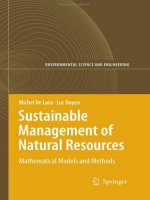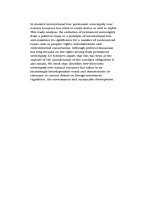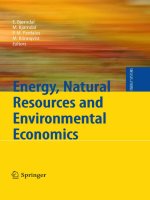Sovereignty over natural resources pdf
Bạn đang xem bản rút gọn của tài liệu. Xem và tải ngay bản đầy đủ của tài liệu tại đây (8.75 MB, 477 trang )
In modern international law, permanent sovereignty over
natural resources has come to entail duties as well as rights.
This study analyses the evolution of permanent sovereignty
from a political claim to a principle of international law,
and examines its significance for a number of controversial
issues such as peoples' rights, nationalization and
environmental conservation. Although political discussion
has long focused on the rights arising from permanent
sovereignty, Dr Schrijver argues that this has been at the
expense of the consideration of the corollary obligations it
also entails. His book thus identifies new directions
sovereignty over natural resources has taken in an
increasingly interdependent world and demonstrates its
relevance to current debate on foreign-investment
regulation, the environment and sustainable development.Sovereignty over
natural resources
CAMBRIDGE STUDIES IN INTERNATIONAL AND COMPARATIVE LAW
This series (established in 1946 by Professors Gutteridge, Hersch Lauterpacht
and McNair) is a forum for studies of high quality in the fields of public and
private international law and comparative law. Although these are distinct
legal sub-disciplines, developments since 1946 confirm their interrelationship.
Comparative law is increasingly used as
a
tool in the making of law at
national, regional and international levels. Private international law is
increasingly affected by international conventions, and the issues faced by
classical conflicts rules are increasingly dealt with by substantive
harmonisation of law under international auspices. Mixed international
arbitrations, especially those involving state economic activity, raise questions
of public and private international law. In many fields (such as the protection
of human rights and democratic standards, investment guarantees, and
international criminal law) international and national systems interact.
National constitutional arrangements relating to 'foreign affairs' and to the
implementation of international norms are
a
focus of attention.
Professor Sir Robert Jennings edited the series from 1981. Following his
retirement as General Editor, an editorial board has been created and
Cambridge University Press has recommitted itself to the series, affirming
its broad scope.
The Board welcomes works of a theoretical or interdisciplinary character,
and those focusing on new approaches to international or comparative law
or conflicts of law. Studies of particular institutions or problems are equally
welcome, as are translations of the best work published in other languages.
General Editors James Crawford
Whewell Professor of International law, University of Cambridge
David Johnston
Regius Professor of
Civil
Law, University of Cambridge
Editorial Board Professor Hilary Charlesworth University of Adelaide
Mr John Collier Trinity
Hall,
Cambridge
Professor Lori Damrosch Columbia University Law
School
Professor John Dugard Director, Research
Centre
for International
Law, University of Cambridge
Professor Mary-Ann Glendon
Harvard
Law
School
Professor Christopher Greenwood
London School
of Economics
Professor Hein Kotz Max-Planck-Institut, Hamburg
Dr Vaughan Lowe Corpus Christi College, Cambridge
Professor D. M. McRae
University
of
Ottawa
Professor Onuma Yasuaki
University
of
Tokyo
Advisory Committee
Professor D. W. Bowett QC
Judge Rosalyn Higgins QC
Professor Sir Robert Jennings QC
Professor
J.
A.
Jolowicz QC
Professor Eli Lauterpacht QC
Professor Kurt Iipstein
Judge Stephen Schwebel
Sovereignty over
natural resources
Balancing
rights and duties
Nico Schrijver
Institute of
Social
Studies, The Hague
vim
CAMBRIDGE
UNIVERSITY PRESS
CAMBRIDGE UNIVERSITY PRESS
Cambridge, New York, Melbourne, Madrid, Cape Town, Singapore, Sao Paulo
Cambridge University Press
The Edinburgh Building, Cambridge CB2 8RU, UK
Published in the United States of America by Cambridge University Press, New York
www.cambridge.org
Information on this title: www.cambridge.org/9780521562690
© Cambridge University Press 1997
This publication is in copyright. Subject to statutory exception
and to the provisions of relevant collective licensing agreements,
no reproduction of any part may take place without the written
permission of Cambridge University Press.
First published 1997
This digitally printed version 2008
A catalogue record for this publication is available from the British Library
Library of Congress Cataloguing in Publication data
Schrijver, Nico, 1954-
Sovereignty over natural resources / Nico Schrijver.
p.
cm.
Includes bibliographical references.
ISBN 0 521 56269 4 (hardback)
1.
Natural resources - Law and legislation. 2. Sovereignty.
3.
Government ownership - Law and legislation. I. Title.
K3478.S37 1997
341.7'62-dc20 96-33595 CIP
ISBN 978-0-521-56269-0 hardback
ISBN 978-0-521-04744-9 paperback
To the memory of
Cornells Schrijver, B. V. A. Roling and Subrata Roy Chowdhury
The
fact that the Rio Grande lacks sufficient water to permit its use by the
inhabitants of
both
countries does not entitle
Mexico
to impose
restrictions
on the
United States which would hamper the development of the latter
f
s territory or
deprive
its inhabitants of an advantage with which nature had endowed it and
which is situated entirely within its territory. To admit
such
a principle would be
completely
contrary to the principle that the United States
exercises
full
sovereignty
over its national territory.
US Attorney-General
Harmon, in
21 Opinions
of
the Attorney-General
of
the United States (1895), p. 283
[T]he emphasis on national sovereignty is partly a transitional problem
which has to be experienced but which will pass by. But it is also
undoubtedly the expression of the new state's weakness, of its need for
protection against external influences. In the Charter of the UN, this
protective law is expressed in the principles of 'sovereign equality* and
of self-determination.
B.
V. A. Roling, International law in an Expanded World
(Djambatan: Amsterdam, 1960), p. 78
It would be a mistake to consider the idea of permanent sovereignty
over resources as anachronistic nationalistic rhetoric. It should be
viewed as a fresh manifestation of present aspirations for self-rule and
greater equality.
O. Schachter, Sharing the World's
Resources
(Columbia University Press: New York, 1977), p. 126
The sovereignty, territorial integrity and independence of States within
the established international system, and the principle of
self-determination for peoples, both of great value and importance,
must not be permitted to work against each other in the period ahead.
Respect for democratic principles at all levels of social existence is
crucial: in communities, within States and within the community of
States. Our constant duty should be to maintain the integrity of each
while finding a balanced design for all.
UN Secretary-General Boutros-Ghali, An
Agenda
for
Peace
(United Nations, New York, 1992), p. 10
Contents
List
of
boxes,
figures
and
tables
xiv
Preface
xvi
Acknowledgments xviii
List
of
abbreviations
xx
List
of
main symbols used
in
UN documents xxiv
Glossary xxvi
Table
of
cases
xxviii
1 Introduction 1
Objectives
of
the study
1
Genesis
of permanent
sovereignty
as a
principle
of
international
law
3
The international context
4
The
subjects:
a
widening and
a
contracting
circle
7
The
objects
to
which permanent
sovereignty
applies
11
Goals
and
objectives
for
the
exercise
of permanent
sovereignty
20
Scope
and
orientation
of
the
study
25
PART
I
The birth
and
development
of
the principle:
the
UN General
Assembly
as
midwife
Introductory remarks
to
Part
I 33
2
The
formative years (1945-1962)
36
The
early
years
(1945-1951):
balancing national
and
global
interests
37
ix
CONTENTS
The
1952
'nationalization'
resolution:
the demand for
economic
independence 41
Linking human rights,
self-determination
and natural
resources
(1952-1955) 49
From self-determination
of
peoples
to
sovereignty
of
States:
the
UN
Commission
on Permanent
Sovereignty over
Natural
Resources
(1958-1961) 57
Bridging the gap: the
near<onsensus
on the
Declaration
on
Permanent
Sovereignty over
Natural
Resources (1962)
70
3 Promoting economic development by the exercise of
permanent sovereignty: the period after 1962 82
Reaffirming and elaborating the
1962 Declaration (1963-1970)
84
Permanent sovereignty over
marine
resources (1970-1972)
90
Towards
the
NIEO
resolutions:
renewed debate on
nationalization
(1972-1973)
92
Steamrollering
it through: the
NIEO Declaration
and Action
Programme (1974)
96
The Charter
of
Economic
Rights and
Duties
of
States (1974)
100
Towards
pragmatism: international
co-operation
in
natural-resource
policy 113
4 Permanent sovereignty, environmental protection and
sustainable development 120
Growing
international
awareness
of
environmental
degradation 120
Early
UN resolutions
on the
conservation
of nature 121
Protecting
the human environment: Stockholm
1972
122
Follow-up
to the
Stockholm Declaration
with
respect
to
permanent
sovereignty
127
The
UN
and the issue of
shared
resources:
the
UNEP Guidelines
of
1978 129
The
Brundtland Experts
Group
on Environmental Law 133
Permanent sovereignty
in an environmental and
developmental
context:
Rio
1992
134
Comparing the
Stockholm
and the Rio
Declarations
139
CONTENTS XI
5 Permanent sovereignty over natural resources in
territories under occupation or foreign administration 143
The
status of Namibia and its natural
resources
before
independence
in
1990
144
Permanent sovereignty
over
'national'
resources
in
Israeli-occupied territories
152
Sovereignty
over the Panama Canal and Zone 156
Summary and appraisal of
Part
I 164
PART II
Natural-resource law in practice: from creeping national
jurisdiction towards international co-operation
Introductory remarks
to
Part II
171
6 International investment law: from nationalism to
pragmatism 173
'National
standard'
versus 'international minimum
standard'
173
Multilateral
codes
of
conduct on
foreign investment 181
Multilateral instruments for promotion and protection of
foreign investment 184
Increasing
popularity of
bilateral
investment treaties 190
International settlement of investment disputes 194
Trend towards pragmatism 195
7 The law of the sea: extension of control over marine
resources 202
'Planet
Ocean'
202
Classical
law on the territorial
sea:
from
'cannonshoV
to
'fixed
distance' 203
Extension
of
territorial sovereignty
over maritime areas 205
Extension of
exclusive economic
jurisdiction over marine
resources 207
A halt to the seaward
rush:
the common heritage of mankind 214
International dispute settlement under the law of the sea 222
Permanent sovereignty
versus common heritage of humankind? 228
Xll CONTENTS
8 International environmental law: sovereignty
versus
the
environment? 231
The
concept
of
international
environmental law 231
Codifying international environmental law 233
Territorial sovereignty
in international
case
law: 'bending
before
all international
obligations'?
236
Principles
of
international
environmental law and state
sovereignty 240
Sovereignty versus
the environment? 249
Appraisal of
Part
II 251
PART III
Balancing rights and duties in an increasingly
interdependent world
Introductory remarks to Part III 255
9 Rights and claims: seeking evidence of recognition in
international law 258
The
grammar of
rights
2 58
The right to
dispose freely
of natural
resources
260
The right to
explore
and exploit natural
resources
freely 264
The right to regain
effective control
and to
compensation
for
damage 266
The
right to use natural
resources
for national development 269
The
right to manage natural
resources
pursuant to national
environmental policy 274
The
right to an
equitable
share in
benefits
of transboundary
natural
resources
276
The right to
regulate
foreign investment 278
The right to expropriate or
nationalize
foreign investment 285
The right to settle disputes on the basis of national law 298
10 Duties: the other side of the coin 306
The
concept
of duties. 306
The
exercise
of permanent
sovereignty
for national development
and the
well-being
of
the people
308
Respect for the rights and interests of
indigenous peoples
311
CONTENTS Xlll
Duty
to
co-operate
for
international development
319
Conservation
and
sustainable use
of
natural wealth
and
resources
324
The
equitable
sharing
of
transboundary natural
resources
336
Respect for international
law
and fair treatment of foreign
investors
339
Obligations
related
to
the right
to
take foreign property
344
II Sovereignty over natural resources as a basis for
sustainable development 368
The
origin,
development
and
legal status
of
the principle
369
Changing perceptions
on
sovereignty,
foreign investment and
the
role
of
international
law 377
Permanent sovereignty
in an
interdependent world
387
Appendices
I United Nations resolutions and other decisions 399
II Table of multilateral treaties 402
III Survey of main cases 410
Bibliography
419
Index
447
Boxes, figures
and
tables
Boxes
2.1 Text of the draft resolution submitted by the
Commission on Permanent Sovereignty over Natural
Resources, 25 May 1961
page
8o
5.1 Decree No. 1 for the Protection of the Natural
Resources of Namibia, 27 September 1974 162
6.1 Characteristic examples of Calvo-flavoured provisions
in legal instruments 197
6.2 Permanent-sovereignty-related provisions in the Draft
UN Code of Conduct on Transnational Corporations 199
6.3 Some illustrative provisions of the 1992 World Bank
Guidelines on the Treatment of Foreign Direct
Investment 200
10.1 Global significance of national management of tropical
rain forests 365
10.2 Examples of nationalization clauses in bilateral
investment treaties 366
Figure
7.1 National jurisdiction over marine resources 230
Tables
2.1 Drafting history of the provisions on permanent
sovereignty in the Human Rights Covenants 77
2.2 General Assembly resolutions on permanent sovereignty
over natural resources (1952-1962) 79
xiv
LIST OF BOXES, FIGURES AND TABLES XV
3.1 General Assembly resolutions on permanent sovereignty
after 1962 119
4.1 General Assembly resolutions on sovereignty over
natural resources and the environment 141
5.1 General Assembly resolutions on permanent sovereignty
over national resources in occupied Palestinian and
other Arab territories 161
Preface
My interest in natural-resource management has deep roots. Born into a
farming family in a small village in West Friesland, in the north of the
Netherlands, I have always cherished the products of nature, initially
because of the economic value they represent.
We
lived in
a
coastal region at
sea level, safely protected by three dikes which have served as lines of
defence against
flooding
since the late fifteenth century. They were called De
Waker ("The Watchman'), De
Dromer
('The Dreamer', to be awakened
whenever the water would reach its foot) and
De Slaper
('The Sleeper'). Only
later was I to become aware of the beauty of these dikes and the
surrounding landscape and of the vulnerability of the natural environ-
ment.
My academic interest in the topic of this book first crystallized when I
took courses in international law, the sociology of international relations,
peace research and the economics of development at the University of
Groningen.
I
thus became acquainted with Third World efforts to establish
a
New International Economic Order. These efforts included claims to full
permanent sovereignty over natural resources and demands for more
equitable commodity prices. The political organs of the United Nations
served as the forum of debate as well as a vehicle for letting off political
steam. But the issue was thrown into sharp relief as Arab petroleum-
exporting countries actively pursued a cartel policy and imposed an oil
embargo against the Netherlands and the USA as a reaction to those
countries' pro-Israeli stand in the aftermath of the
Yom
Kippur War in 1973.
Ever since this time, various developments such as the deterioration in the
terms of trade of many developing countries, the reshaping of the
international order, resource conflicts, as well as mounting concern about
environmental deterioration and how to achieve a sustainable use of the
natural resources, have made a deep impression on me. In the meantime,
xvi
PREFACE XV11
North-South relations have changed considerably, with newly industrial-
izing countries in the South not being keen to join Group of 77 forces in
demanding higher commodity prices since they
have
become net importers
themselves. Simultaneously, awareness has arisen that preservation of the
world's environment and natural wealth is a 'common concern of human-
kind' and that sovereignty is not an unqualified concept behind which
governments can hide in claiming that matters within domestic jurisdic-
tion are 'no outsider's business'. Developments in human rights law, law of
the sea, international economic and environmental law, all have given rise
to the principle that States are increasingly accountable, both at an
international and domestic level, for the way they manage their natural
wealth and resources.
Although my work over the years has often followed different paths, I
have frequently returned to consider the successes and failures of the UN's
contribution to promoting development of developing countries, to
preserving the environment, and to developing and consolidating interna-
tional law.
Acknowledgments
I
would like to record my
deep
appreciation to Professor
W.
D.
Verwey of the
University of Groningen and to Professor
P.
J. I. M. de Waart of the 'Vrije
Universiteit' in Amsterdam for skilfully guiding me during the long march
of writing this book, often blocking my way when I was distracted by
attractive
side-roads.
Participants and staff at the Institute of Social Studies
(ISS) in The Hague, colleagues in the Evert Vermeer Foundation, the
National Advisory Council for International Development Co-operation, the
International
Law
Association and at the UN Secretariat in
New
York have
formed an inspiring multicultural and interdisciplinary community for me
which has profoundly influenced my perspective on the role of interna-
tional law in international as well as domestic affairs.
This study has also greatly benefited from the wise advice and valuable
comments of
a
number of colleagues and friends, particularly: Paul
Peters,
a
former legal adviser to companies of the Royal Dutch/Shell Group, who
graciously shared with me his wide knowledge and experience; Professor
James Crawford, general editor of Cambridge University Press's interna-
tional law
series;
Professor Arthur
Westing,
formerly with
SIPRI
and author
of books on environment and security; Professor Barbara Kwiatkowska,
Deputy Director of the Netherlands Institute for the Law of the Sea at
Utrecht University; Dr Johan Kaufmann, former Netherlands Ambassador
to the United Nations; Professor Hans Opschoor, Rector of the
ISS;
Jan van
Ettinger, a former Director of Jan Tinbergen's
RIO
Project and now with the
Geneva-based Independent World Commission on the Oceans; Professor
Peter Sand of the University of Munich; Professor Godried van Benthem van
den Bergh of the
ISS;
Marnix
Krop,
Netherlands Ministry of Foreign Affairs;
and my dear international law friends, Karin Arts and Ige Dekker.
Words of thanks are also due to the librarians of the Institute of Social
Studies, of the Peace Palace in The Hague and the Palais des Nations in
xviii
ACKNOWLEDGMENTS
xix
Geneva,
of
the documentation section
of
the Netherlands Ministry
of
Foreign Affairs and of the
T.
M.
C.
Asser Institute; to my colleagues in the
International Studies Group of the
ISS:
Dr Jessica
Byron,
Dr Surya Subedi, Dr
Thamh-Dam Truong, Janna van der Meulen and Antoinette Hildering as
well as Professors Bas de Gaay Fortman, Jeffrey Harrod and Joop Syatauw;
and to Ank van den
Berg,
who assisted me after office hours in overcoming
my computer ineptitudes.
I
sincerely thank Gary Debus and Josephine
Bosman of the ISS publications department for skilfully editing this text;
Joy
Misa
and
Koos
van Wieringen of the
ISS
and Christopher Hart and other
staff at Cambridge University Press for preparing the text for publication.
My wife, Yuwen Li,
is
the author of a book which includes
a
thorough
examination
of
the common heritage
of
humankind,
a
principle upon
which
a
halt to State sovereignty over natural resources has been based.
Similarly, she was instrumental, in her own ever-stimulating and decisive
way,
in
making
me
realize that
my
own personal sovereignty
is not
permanent and subject to duties as well as rights.
I regret that Cornelis Schrijver (my father),
B.
V.
A.
Roling (Professor of
International Law
and
Peace Research, Groningen)
and
Subrata
Roy
Chowdhury (Senior Advocate, Calcutta High Court and Supreme Court of
India),
all of whom in different phases of my life taught me
a
great deal
about the true meaning of equity, are no longer with us. In gratitude for
their contribution I dedicate this book to their memory.
While gratefully acknowledging the support
of
many, any errors and
shortcomings are my own responsibility.
Abbreviations
AALCC Asian-African Legal Consultative Committee
ACP African, Caribbean and Pacific States (parties to the Lome
Conventiong approx. 70)
AFDI Annuaire Frangais de Droit International
AJICL African journal of International and Comparative Law
AJIL American Journal of International Law
ALI American Law Institute
APEC Asia-Pacific Economic Co-operation
Area Sea-bed and ocean floor and subsoil thereof beyond the
limits of national jurisdiction in accordance with the 1982
UN Convention on the Law of the Sea
ASEAN Association of South-East Asian Nations
ASIL American Society of International Law
BISD Basic Instruments and Selected Documents (of GATT)
BITs Bilateral investment treaties
BYIL British Yearbook of International Law
CERDS 1974 Charter of Economic Rights and Duties of States
CHM Common heritage of (hu)mankind
CIME OECD Committee on International Investment and
Multinational Enterprises
CIS Commonwealth of Independent States
CITES 1973 Convention on International Trade in Endangered
Species of Wild Fauna and Flora
CJTL Columbia Journal of Transnational Law
DD II/III/IV Development Decades II-IV (of the UN)
ECLAC Economic Commission for Latin America and the
Caribbean (of the UN)
ECOSOC Economic and Social Council (of the UN)
xx
LIST OF ABBREVIATIONS XXI
EC European Community
ECE Economic Commission
for
Europe
(of the UN)
EEC European Economic Community
ECT Energy Charter Treaty
EEZ Exclusive economic zone
EJIL European journal
of
International
Law
EPL Environmental Policy
and Law
EU European Union
FAO Food
and
Agriculture Organization
of the
United Nations
FCCC
UN
Framework Convention
on
Climate Change
FCN Friendship, Commerce
and
Navigation Treaties
GA General Assembly
(of the UN)
GAOR
General
Assembly
Official
Records
GATT General Agreement
on
Tariffs
and
Trade
GEF Global Environment Facility
GYIL German Yearbook
of
International
Law
IAEA International Atomic Energy Agency
IBRD International Bank
for
Reconstruction
and
Development
(the World Bank)
ICA International Co-operative Alliance
(a
consumers
organization)
ICC International Chamber
of
Commerce
ICJ International Court of Justice
IC]
Reports International Court of Justice, Reports of judgments, Advisory
Opinions
and
Orders
ICLQ International
and
Comparative
Law
Quarterly
ICSID International Centre
for the
Settlement
of
Investment
Disputes
ICSID Convention Establishing
the
International Centre
for the
Convention Settlement
of
Investment Disputes between States
and
Nationals
of
Other States
IDA International Development Association
IEA International Energy Agency
IEL International Environmental
Law (5
vols., Erich Schmidt
Verlag: Berlin,
1974)
IFC International Finance Corporation
IFDA International Foundation
for
Development Alternatives
IGC Intergovernmental Committee
IJIL Indian journal
of
International
Law
ILA International
Law
Association
XXII
LIST OF ABBREVIATIONS
ILC International
Law
Commission
(of the UN)
ILM International Legal Materials
ILO International Labour Organization
ILR
International
Law
Reports
IMF International Monetary Fund
Iran-US
CTR
Iran-US Claims Tribunal Reports
ITTA International Tropical Timber Agreement
IUCN International Union
for
Conservation
of
Nature
and
Natural Resources (now World Conservation Union)
JWT
or
JWTL Journal
of
World Trade (formerly Journal
of
World Trade Law)
LJIL
Leiden Journal of International
Law
LNTS League
of
Nations Treaty Series
Martens
NRG
Martens Nouveau Recueil General
de
Traites
MERCOSUR Mercado Comun
del Sur
(trade area between Argentina,
Brazil, Paraguay
and
Uruguay)
MIGA Multilateral Investment Guarantee Agency
MITs Multilateral investment treaties
NAFTA North American Free Trade Agreement
NAM Non-Aligned Movement
NGOs Non-Governmental Organizations
NIEO
New
International Economic Order
NILR
Netherlands International
Law
Review
NJB
Nederlands Juristenblad
nm
nautical mile (1,851.85
m)
NQHR Netherlands Quarterly
of
Human Rights
NYIL Netherlands Yearbook
of
International
Law
NYUJILP
New
York University Journal
of
International
Law and
Politics
OAU Organization
of
African Unity
OECD Organization
for
Economic Co-operation
and
Development
Off. Rec.
Official Records
of
UNCLOS III
OIC Organization
of the
Islamic Conference
OAPEC Organization
of
Arab Petroleum Exporting Countries
ODA Official Development Assistance
ODIL
Ocean Development
and
International
Law
OPEC Organization
of
Petroleum Exporting Countries
PGA Permanent Court
of
Arbitration
PCIJ Permanent Court
of
International Justice
LIST
OF
ABBREVIATIONS
XX111
Recueil des
Recueil des Cours de l'Academie de Droit International de
Cours
la
Haye
Res.
Resolution(s)
RIAA Reports
of
International Arbitral Awards
RIO Project 'Reshaping
the
International Order' (A Report
to
the Club
of
Rome, Coordinator Jan Tinbergen,
1976)
SIPRI Stockholm International Peace Research Institute
SUNFED Special United Nations Fund
for
Economic Development
SWAPO South-West Africa's [Namibia's] People's Organization
TDB Trade
and
Development Board
(of
UNCTAD)
TNCs Transnational corporations
TRIMs Trade-Related Investment Measures
UAR United Arab Republic (of Egypt
and
Syria,
1958-61:
Egypt
up
to
1971)
UCN Ultra Centrifuge Nederland
UK United Kingdom
UKTS United Kingdom Treaty Series
UN United Nations
UNCED UN Conference
on
Environment
and
Development
UNCIO UN Conference
on
International Organization (the
San
Francisco Conference, June 1945)
UNCITRAL
UN
Commission
on
International Trade
Law
UNCLOS UN Conference
on the
Law
of
the
Sea
UNCTAD UN Conference
on
Trade
and
Development
UNCTC UN Centre
on
Transnational Corporations
UNDP UN Development Programme
UNEP UN Environment Programme
UNESCO UN Educational, Scientific
and
Cultural Organization
UNGA UN General Assembly (also given
as
General Assembly)
UNIDIR UN Institute
for
Disarmament Research
UNIDO UN Industrial Development Organization
UNITAR UN Institute
for
Training
and
Research
UNTAG UN Transition Assistance Group
(in
Namibia)
UNTS UN Treaty Series
UNYB UN
Yearbook
WCED World Commission
on
Environment
and
Development
WMO World Meteorological Organization
WTO World Trade Organization
ZaoRV Zeitschrift fiir ausldndisches ojfentliches Recht
und
Volkerrecht
Main symbols used
in UN
documents
A/- General Assembly. Starting with the thirty-first session of
the General Assembly in 1976, symbols were expanded to
include Arabic numerals denoting the session
(e.g.,
A/31/-,
A/32/-,
A/C.l/31/-,
etc.).
A/S-
General Assembly Special Session. From the first to the
seventh special session 'S' followed by a roman numeral
denoting the session, was added to the normal resolution
symbols (e.g., GA Res. 3202 (S-VI)). With regard to docu-
ments no special mention was made. Starting with the
eighth special session in 1978, the symbol'S' was followed
by Arabic numeral(s) denoting the session (e.g., A/S-8/2,
A/RES/S-8/1).
E/- Economic and Social Council
S/- Security Council
ST/-
Secretariat
Special basic series symbols have been established for certain bodies:
ID/-
UN Industrial Development Organization
TD/-
UN Conference on Trade and Development
UNEP/- UN Environment Programme
UNITAR/- UN Institute for Training and Research
UNIDIR/- UN Institute for Disarmament Research
The documents of the subsidiary organs normally carry a symbol consisting
of the basic series symbol of the parent body plus one or more of the
following elements:
-/AC /-
Ad
hoc
committee or similar body
xxiv
LIST OF MAIN SYMBOLS USED IN UN DOCUMENTS XXV
-/C /-
Standing, permanent or sessional committee
-/CN /- Commission
-/CONF-/-
Conference
-/GC /-
Governing Council
-/WG /- Working Group
-/WP./-
Working Party
The documents of some subsidiary organs bear a symbol consisting of the
basic series symbol of the parent body followed by the acronym of the
subsidiary organ:
ST/CTC/- UN Centre on Transnational Corporations
TD/B/-
Trade and Development Board
The following elements may be added to the series symbol and denote the
nature or distribution of the document
-/INF
Information series
-/PV Verbatim records of meetings
(proces-verbaux)
-/RES./-
Mimeographed texts of adopted resolutions
-/SR Summary records of meetings
-/WP
Working Paper
-/L-
Limited distribution
The following elements, if added, denote modification of a previous text:
-/Add Addendum. Indicates an addition of text to the main
document.
-/Corr Corrigendum. Indicates modification of any specific part of
an existing document to correct errors, revise wording or
reorganize text, whether for substantive or technical
reasons.
-/Rev Revision. Indicates a new text which supersedes and
replaces that of a previously issued document.
Source:
United Nations Document Series Symbols (Dag Hammarskjold
Library, New York, 1986), UN Doc. ST/LIB/SER.B/5/Rev.4 (sales no. E.85.I.2)









